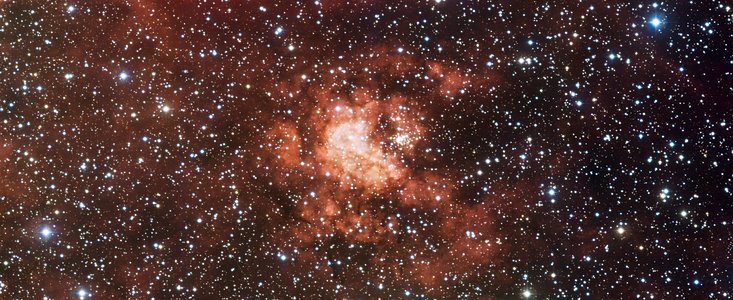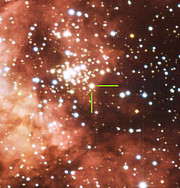Comunicato Stampa
A claret-coloured cloud with a massive heart
21 Ottobre 2008
A new image released by ESO shows the amazing intricacies of a vast stellar nursery, which goes by the name of Gum 29. In the centre, a small cluster of stars — called Westerlund 2 — has been found to be the home of one of the most massive double star systems known to astronomers.
Gum 29 is a huge region of hydrogen gas that has been stripped of its electrons (ionised) by the intense radiation of the hot young stars located at its centre. Astronomers call this an HII (pronounced "H-two") region, and this particularly stunning example stretches out across space for over 200 light-years. The name stems from the fact that it is the 29th entry in the catalogue published by Australian astronomer Colin Stanley Gum in 1955.
Embedded deep within the huge, nebulous expanse of Gum 29, the relatively little known cluster of Westerlund 2 is clearly seen in the centre of this image. The latest measurements indicate that it lies at a distance of some 26 000 light-years from Earth, placing it towards the outside edge of the Carina spiral arm of the Milky Way. The cluster's distance has been the subject of intense scrutiny in the past, as it is one of the parameters needed to understand this intriguing object. Westerlund 2 is very young too, with an age of only 1—2 million years.
Previous observations have shown that two stars to the bottom right of the cluster are true leviathans. Together they form what is known as a double system. The two stars have masses of 82 and 83 times that of our Sun and rotate around each other in approximately 3.7 days. They are amongst the most massive stars known to astronomers.
Detailed observations of this intriguing pair have also shown that they are both Wolf-Rayet stars. These are massive stars nearing the end of their lives, expelling vast quantities of material as their final swansong. Observations made in X-rays have subsequently shown that streams of material from each star continually collide, creating a blaze of X-ray radiation.
The image was obtained with the Wide Field Imager (WFI) camera attached to the 2.2-m Max-Planck/ESO telescope at ESO's La Silla observatory site in Chile. Located at an altitude of 2400 metres in the arid Atacama Desert, this observatory sits under some of the clearest and darkest skies on Earth. The WFI excels at studying the farthest depths of the Universe from this unrivalled vantage point.
Contatti
Henri Boffin
ESO
Garching, Germany
Tel.: +49 89 3200 6222
E-mail: hboffin@eso.org
Valentina Rodriguez
ESO
Chile
Tel.: +56 2 463 3123
E-mail: vrodrigu@eso.org
Sul Comunicato Stampa
| Comunicato Stampa N": | eso0837 |
| Legacy ID: | PR 37/08 |
| Nome: | Gum 29 |
| Tipo: | Milky Way : Nebula |
| Facility: | MPG/ESO 2.2-metre telescope |
| Instruments: | WFI |
Our use of Cookies
We use cookies that are essential for accessing our websites and using our services. We also use cookies to analyse, measure and improve our websites’ performance, to enable content sharing via social media and to display media content hosted on third-party platforms.
ESO Cookies Policy
The European Organisation for Astronomical Research in the Southern Hemisphere (ESO) is the pre-eminent intergovernmental science and technology organisation in astronomy. It carries out an ambitious programme focused on the design, construction and operation of powerful ground-based observing facilities for astronomy.
This Cookies Policy is intended to provide clarity by outlining the cookies used on the ESO public websites, their functions, the options you have for controlling them, and the ways you can contact us for additional details.
What are cookies?
Cookies are small pieces of data stored on your device by websites you visit. They serve various purposes, such as remembering login credentials and preferences and enhance your browsing experience.
Categories of cookies we use
Essential cookies (always active): These cookies are strictly necessary for the proper functioning of our website. Without these cookies, the website cannot operate correctly, and certain services, such as logging in or accessing secure areas, may not be available; because they are essential for the website’s operation, they cannot be disabled.
Functional Cookies: These cookies enhance your browsing experience by enabling additional features and personalization, such as remembering your preferences and settings. While not strictly necessary for the website to function, they improve usability and convenience; these cookies are only placed if you provide your consent.
Analytics cookies: These cookies collect information about how visitors interact with our website, such as which pages are visited most often and how users navigate the site. This data helps us improve website performance, optimize content, and enhance the user experience; these cookies are only placed if you provide your consent. We use the following analytics cookies.
Matomo Cookies:
This website uses Matomo (formerly Piwik), an open source software which enables the statistical analysis of website visits. Matomo uses cookies (text files) which are saved on your computer and which allow us to analyze how you use our website. The website user information generated by the cookies will only be saved on the servers of our IT Department. We use this information to analyze www.eso.org visits and to prepare reports on website activities. These data will not be disclosed to third parties.
On behalf of ESO, Matomo will use this information for the purpose of evaluating your use of the website, compiling reports on website activity and providing other services relating to website activity and internet usage.
Matomo cookies settings:
Additional Third-party cookies on ESO websites: some of our pages display content from external providers, e.g. YouTube.
Such third-party services are outside of ESO control and may, at any time, change their terms of service, use of cookies, etc.
YouTube: Some videos on the ESO website are embedded from ESO’s official YouTube channel. We have enabled YouTube’s privacy-enhanced mode, meaning that no cookies are set unless the user actively clicks on the video to play it. Additionally, in this mode, YouTube does not store any personally identifiable cookie data for embedded video playbacks. For more details, please refer to YouTube’s embedding videos information page.
Cookies can also be classified based on the following elements.
Regarding the domain, there are:
- First-party cookies, set by the website you are currently visiting. They are stored by the same domain that you are browsing and are used to enhance your experience on that site;
- Third-party cookies, set by a domain other than the one you are currently visiting.
As for their duration, cookies can be:
- Browser-session cookies, which are deleted when the user closes the browser;
- Stored cookies, which stay on the user's device for a predetermined period of time.
How to manage cookies
Cookie settings: You can modify your cookie choices for the ESO webpages at any time by clicking on the link Cookie settings at the bottom of any page.
In your browser: If you wish to delete cookies or instruct your browser to delete or block cookies by default, please visit the help pages of your browser:
Please be aware that if you delete or decline cookies, certain functionalities of our website may be not be available and your browsing experience may be affected.
You can set most browsers to prevent any cookies being placed on your device, but you may then have to manually adjust some preferences every time you visit a site/page. And some services and functionalities may not work properly at all (e.g. profile logging-in, shop check out).
Updates to the ESO Cookies Policy
The ESO Cookies Policy may be subject to future updates, which will be made available on this page.
Additional information
For any queries related to cookies, please contact: pdprATesoDOTorg.
As ESO public webpages are managed by our Department of Communication, your questions will be dealt with the support of the said Department.


